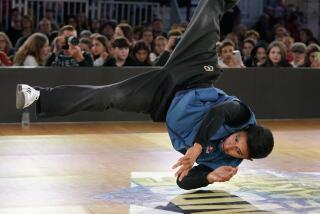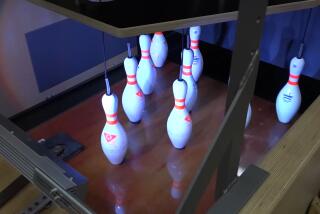Birdie watching
- Share via
The badminton of my youth was a summertime activity of granddads and grass, a leisurely outing on the back lawn where everyone delighted in whacking the plastic birdie for high, arching loops. Back and forth, back and forth, back and forth. It was as exciting as it sounds.
Three decades later, I find myself focused on an indoor badminton court opposite a man old enough to be my grandfather. It’s Lee Chronert of the Burbank Badminton Club. He’s 89.
Chronert and his 70ish partner beat the badminton pants off me and my partner, an experienced player also in his 70s. Chronert and his partner knew how, when and where to hit the shuttle, or shuttlecock. I was the weak link, whiffing occasionally in pursuit of this officially feathered version of the “birdie.”
Competitive badminton -- said to be the world’s fastest racket sport -- demands quick reflexes, sharp concentration and nimble footwork. When played by younger skilled athletes, with shuttles reaching speeds of 200 mph, it is also a ferocious workout.
“A lot of people think badminton is for picnics and that you just piddle around,” said Jacque Gibson, co-chairman of the Burbank Badminton Club, who’s been playing since 1974. “It’s a real sport.”
Although not a popular sport in the United States, badminton ranks just behind soccer as the world’s most popular sport. The game enjoys its largest following in Asia, and nations such as China and Indonesia tend to dominate international competition.
Badminton’s origins go back thousands of years to various forms of games played in China, Greece and India. The game is said to have earned its English name in the 1800s, when British military officers returning from India brought the sport back to an estate in Badminton, Gloucestershire. Badminton became an Olympic sport at the 1992 summer games.
Despite its relative obscurity in the United States, Southern California offers dozens of places, public and private, to play. While the Orange County Badminton Club boasts the largest such facility in the Western Hemisphere -- 12 courts, pro shop and air conditioning -- plenty of local high school gyms, recreation centers and colleges also allot time for badminton. A comprehensive list of where to play can be found on the Southern California Badminton Assn.’s Web site at www.scbabadminton.org.
I’ve always been fond of racket sports, particularly tennis, and I felt sure the skills would easily transfer to badminton. They did, sort of. Particularly as play went on, I could more or less hit the four major shots -- lob, drive, drop and smash. (I had the most trouble with the latter.) As I quickly learned, badminton requires a lot of wrist action -- a cardinal sin in tennis. Thus, years of conditioning often had me lining up for shots in a manner far too slow and cumbersome for a badminton game.
The court and racket took some getting used to. Rackets weigh about 3 ounces, and the hitting surface, about the size of a salad plate, is much smaller than oversized tennis rackets. The court is only about 20 feet by 20 feet on either side of a 5-foot-high net, which rises another inch at the end poles.
That doesn’t sound like much space to cover, especially when playing doubles, but it is. Footwork is the key, and drop shots -- those that barely clear the net and plummet to the ground -- are a big part of the game. A game of doubles requires a lot of scrambling. The bursts add up. It’s said that during a game of average skill, players will run about a mile.
It took me about an hour and 15 minutes to get in four games. Sweating is probably too strong an image to characterize the workout. It was more in the lightly perspiring zone for me.
Of course, much of this was due to my inexperience. But with patience and practice, the brisk and friendly game would be a far more invigorating workout.
*
(BEGIN TEXT OF INFOBOX)
Snapshot: Badminton
Duration of activity: 1 hour, 15 minutes
Calories burned: 575
Heart rate*: Average, 131; high, 169
*This information was obtained using a heart-rate monitor.
*
Martin Miller can be reached by e-mail at martin.miller@latimes.com.


